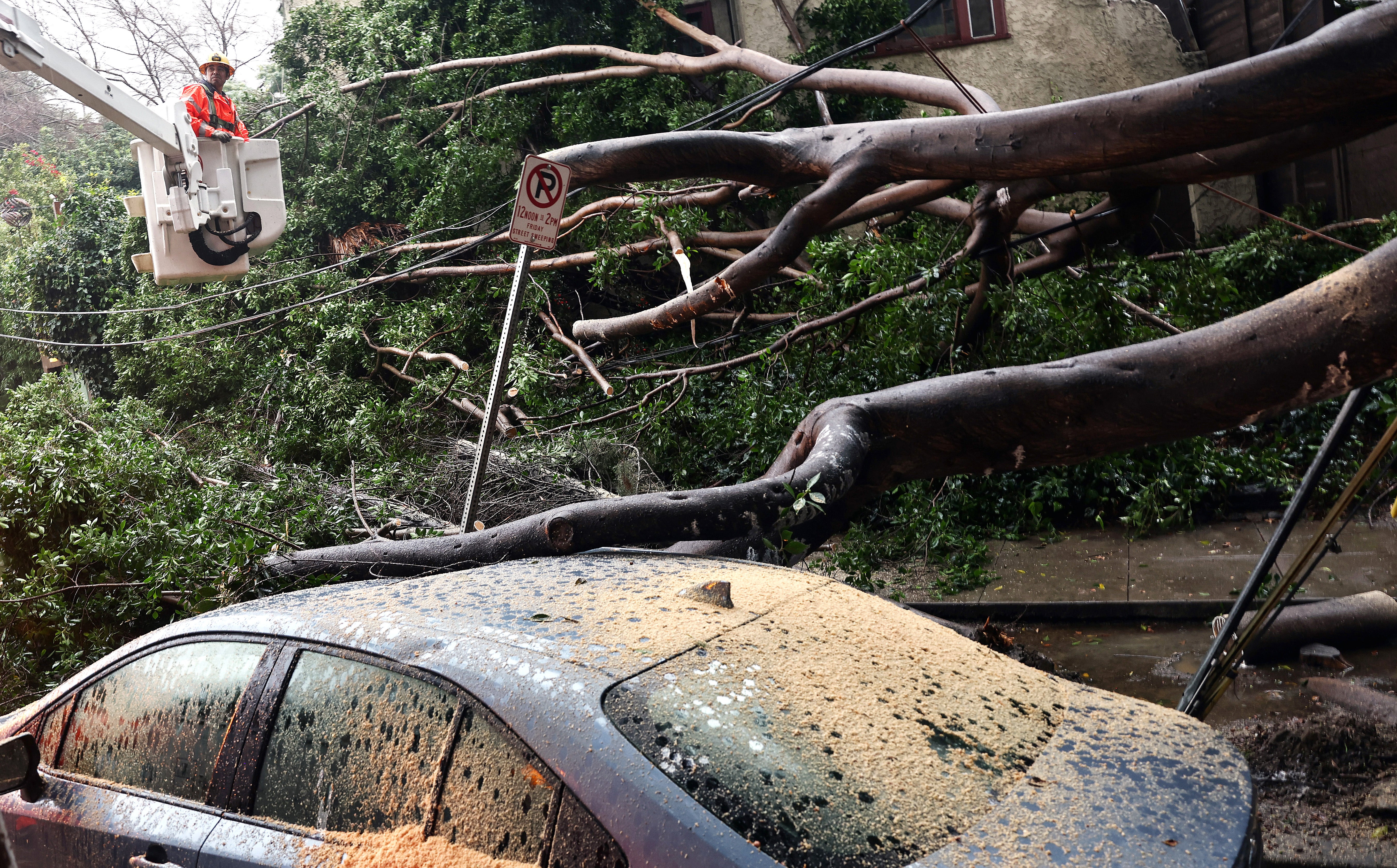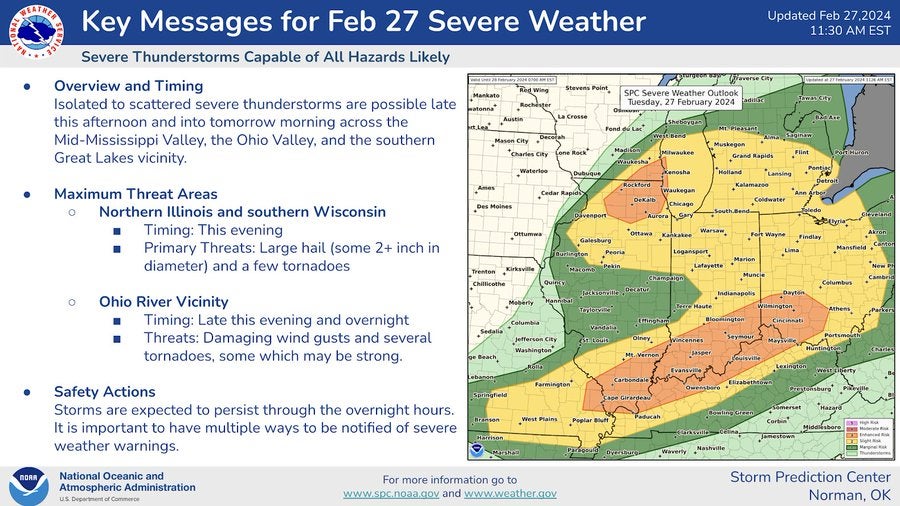Chicago faces severe weather threats with tornadoes and golf ball sized hail possible
Heavy snowfall and winds in the West could create travel chaos as conditions become dangerous for both road and air travel
Your support helps us to tell the story
From reproductive rights to climate change to Big Tech, The Independent is on the ground when the story is developing. Whether it's investigating the financials of Elon Musk's pro-Trump PAC or producing our latest documentary, 'The A Word', which shines a light on the American women fighting for reproductive rights, we know how important it is to parse out the facts from the messaging.
At such a critical moment in US history, we need reporters on the ground. Your donation allows us to keep sending journalists to speak to both sides of the story.
The Independent is trusted by Americans across the entire political spectrum. And unlike many other quality news outlets, we choose not to lock Americans out of our reporting and analysis with paywalls. We believe quality journalism should be available to everyone, paid for by those who can afford it.
Your support makes all the difference.An unusually warm winter will bring severe thunderstorms to much of the country as the Western US is blanketed in heavy snow.
The Midwest and Great Lakes saw record-breaking warmth on 26 and 27 February — but with temperatures rising and falling rapidly, severe thunderstorms, golf-ball-sized hail and tornadoes could hit the area as the month ends, according to the National Weather Service (NWS).
Meanwhile, areas of ten states in the West are under winter storm warnings as of 27 February. California could also see ten feet of snow in mountain areas later this week, according to the NWS.
Avalanche warnings are also in place for parts of Montana. Severe weather has already triggered avalanches this year — in early February, emergency crews had to rescue four people after an avalanche hit the Lee Canyon ski resort in Nevada. That same week, a skier in Wyoming was seriously injured after an avalanche carried her 1,500 feet.
These blizzard conditions could sow travel chaos throughout the country. In previous severe weather events, hundreds of flights were cancelled and road conditions became deadly. Last month, a severe winter storm across most of the country killed at least 89 people.
Areas of ten states under winter weather alerts
Portions of ten states are under winter weather alerts from the National Weather Service (NWS) as of Tuesday afternoon.
Heavy snow combined with strong winds across these states will create “near-blizzard conditions, resulting in dangerous travel,” the NWS forecasts.
Residents should stay off the roads as snow starts to fall today. Last month, a devastating winter storm that made roads across the country undrivable resulted in at least 89 deaths.
These alerts are impacting Colorado, Idaho, Montana, North Dakota, Minnesota, Oregon, Utah, South Dakota, Washington and Wyoming.
Parts of Montana are also under an avalanche warning. Earlier this month, emergency crews had to rescue four people after an avalanche hit the Lee Canyon ski resort in Nevada. Around the same time, a skier in Wyoming was seriously injured after an avalanche carried her 1,500 feet.
California braces for ten feet of snow in mountain areas
A high-impact winter storm will hit the Sierra Nevada mountains in central California this week, the National Weather Service (NWS) said.
The snow will begin to fall on Thursday and last through Sunday. Travel in the area will be “difficult to impossible,” the NWS said, and strong winds may cause air travel disruptions.
Residents should avoid travel if at all possible and carry emergency kits if it is unavoidable.
Two-inch hail expected in Great Lakes region
Hail two inches or greater — roughly the size of a golf ball or egg — could hit parts of southwestern Michigan, Illinois, Indiana, and southeastern Missouri, the National Weather Service (NWS) forecasts.
The hail will come amid severe thunderstorms hitting the region as temperatures rapidly rise and fall following record-high temperatures in the Great Lakes and Midwest this week.
Tornadoes and high winds will also be possible amid these storms, set to begin today.
California already expecting more snow as it recovers from massive storm last week
As California braces for up to ten feet of snow in the mountain regions, residents are also recovering from a barrage of floods and mudslides last week.
Road blockages, landslides and toppled trees were reported in and around Los Angeles as rain battered the region. A massive tree also crashed in a Los Angeles neighbourhood last week, damaging parked vehicles and downing power lines.
Portions of the US-101 and Pacific Coast Highway were also blocked last Monday as rainfall intensified and floodwaters rushed onto the major roadway.

NWS releases timing for massive hail storm in Great Lakes region
The National Weather Service forecasts egg-sized hail will begin to fall in northern Illinois this evening before hitting the Ohio River region late tonight and early tomorrow morning.

Hail hit Tennessee before moving northward
The National Weather Service forecasted a hailstorm in Kentucky this morning. The storm comes hours before the Great Lakes region is set to see massive hail — the size of a golf ball or egg — this evening and overnight into tomorrow.
Chicago could hit 75F today
Forecasters expect the Windy City to hit 75F today. The all-time-high February temperature in Chicago was set at 75F in 1976, NBC Chicago reports, meaning the city could be on track to smash yet another record.
Yesterday, Chicago set a high-temperature record for 26 February as the city hit 71F.
This unseasonal warmth is contributing to the massive storm set to hit the region tonight, as the warm air collides with the cold front passing through.
What’s fueling the thunderstorms and massive hail in the Great Lakes region?
As Chicago temperatures approach 75F today, a jet stream and cold front will blow into the Midwest and Great Lakes regions.
As these different air temperatures collide, severe thunderstorms bringing golf-ball-sized hail and even tornadoes could develop Tuesday evening into Wednesday morning, according to the National Weather Service (NWS).
Chicago broke high-temperature record on Monday
On Monday, Chicago hit 71F, smashing the previous high-temperature record of 64F for 26 February. Tuesday could bring even higher temperatures, with forecasters predicting the Windy City could beat the all-time February record of 75F set in 1976.
This unseasonally-warm weather will fuel the thunderstorms, hail and possible tornadoes expected tonight and into Wednesday morning.
SEE IT: Snow squall passes over Western US
Ten states are under winter weather alerts from the National Weather Service on Tuesday.
Many of those storms are thanks to a cold front passing through the Rocky Mountains as well as the Central and Northern Plains today, creating snow squalls and the potential for thunderstorms throughout the region.

Join our commenting forum
Join thought-provoking conversations, follow other Independent readers and see their replies
Comments